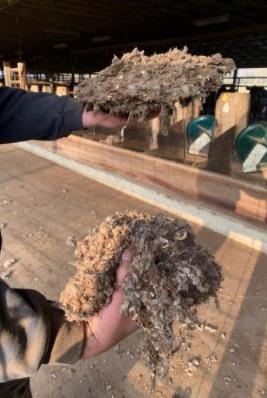The cotton industry generates several byproducts which can be used as beef cattle feeds. Common byproducts used in the Southeastern United States include cottonseed meal, cottonseed hulls, gin trash (gin byproduct), and whole cottonseed. Whole cottonseed and gin trash are often used as a component of winter feed management systems in cow-calf or stocker operations. Within the last three decades, improvements have been made not only in cotton varieties, but also in the harvesting and ginning efficiency. These may have altered quality and feeding practices of cotton byproducts because of changes in seed size and composition. Two research trials were conducted to evaluate if the current feeding recommendations for whole cottonseed and gin trash are still up-to-date given the changes in cotton production and processing over the last thirty years. The studies were designed to address the following questions:
- Have changes in cotton varieties affected feeding practices of whole cottonseed?
- How does cotton gin trash processing influence feed value and animal performance?
Have changes in cotton varieties affected feeding practices of whole cottonseed?
Growing beef steers and bulls with an average body weight of 618 pounds were provided free-choice whole cottonseed from either the ultra-low gossypol or the DeltaPine 1646 B2XF cotton seed variety. Over a 2-week period, animals were acclimated to diets containing whole cottonseed. Following this period, whole cottonseed intake was measured over a 7-day period.
Calves that were fed the DeltaPine variety consumed an average of 2.5 pounds per head daily. Animals on the ultra-low gossypol variety ate near 5 pounds per head daily. Seed size for the ultra-low gossypol variety was greater than the DeltaPine variety, which may have increased palatability and overall daily seed intake. This illustrates how cotton variety differences or gossypol levels may potentially influence feed characteristics.
In order to limit fat intake, the general daily recommended feeding rate of whole cottonseed in growing cattle is 0.33% of the animal’s body weight. Cattle consuming the DeltaPine variety consumed close to this level (0.39% of animal body weight), whereas those on the ultra-low gossypol variety reached almost twice the recommended level of intake (0.78% of animal body weight). Animals consuming the ultra-low gosspyol variety exceeded recommended daily fat intake levels, but those on the DeltaPine variety did not.
This information demonstrates that whole cottonseed consumption may be influenced by cotton variety or gossypol levels. However, cottonseed sourced from gins will consist of a mixture of seed from various commercially available cotton varieties. One of the main foundations of whole cottonseed feeding recommendations is fat. Results from this study indicate that feeding levels of 0.33% of animal body weight for growing beef cattle is still appropriate to keep fat intake within the recommended range.
How does cotton gin trash processing influence feed value and animal performance?

Baled Gin Trash
Cotton gin trash, sometimes called cotton gin byproduct, is composed of lint, burs, stems, cottonseed, and seed fragments. Traditionally, gin trash is stacked in large piles outside of a cotton ginning facility, and is a low bulk density feed. This feed source is used as a roughage replacement in beef cattle diets. Gin trash feed value is roughly equivalent to a low to mid-quality hay. Some cotton gins have invested in equipment to pack gin trash into 550 to 600 pound rectangular bales. Baled gin trash can be stored out of the weather and eases transportation by enabling a producer to haul gin trash in smaller loads.
Based on feed samples of loose and baled gin trash, nutritional value can vary between these forms. A feed intake trial was conducted with dry, pregnant beef cattle to determine overall intake and performance when fed loose or baled gin trash. Cows consumed 2.0% of their body weight per day of loose trash, and 1.8% of their body weight per day in baled gin trash. This is equivalent to expected daily dry matter intake of cattle of similar size and production stage (~2.0% of animal body weight).
Nutritional value of gin trash used in the trial is presented in table 1, which illustrates that energy value (TDN) of gin trash is low, but moderate protein value (CP) is provided. In this study, cows were fed 4 pounds per head daily of a 50/50 soyhulls and corn gluten feed supplement to help meet nutritional demands. All cows maintained a body condition score of 5 or greater in the study and gained weight during the trial. This information demonstrates that baled or loose gin trash may be used as an alternative roughage source and can support dry cow performance with appropriate supplementation. When developing feeding plans with gin trash, a feed quality analysis is important to determine the amount of supplementation required to meet animal needs.
Table 1. Nutritional Value of Gin Trash
Source : aces.edu